2019/April Braindump2go AZ-102 Exam Dumps with PDF and VCE New Updated Today! Following are some new AZ-102 Exam Questions:
1.|2019 Latest AZ-102 Exam Dumps (PDF & VCE) Instant Download:
https://www.braindump2go.com/az-102.html
2.|2019 Latest AZ-102 Exam Questions & Answers Instant Download:
https://drive.google.com/drive/folders/1yGAgUGAZkiDyL4FP1-97kh4N_hjURby9?usp=sharing
QUESTION 45
Drag and Drop Question
You have an on-premises file server named Server1 that runs Windows Server 2016.
You have an Azure subscription that contains an Azure file share.
You deploy an Azure File Sync Storage Sync Service, and you create a sync group.
You need to synchronize files from Server1 to Azure.
Which three actions should you perform in sequence? To answer, move the appropriate actions from the list of actions to the answer area and arrange them in the correct order.
Answer: 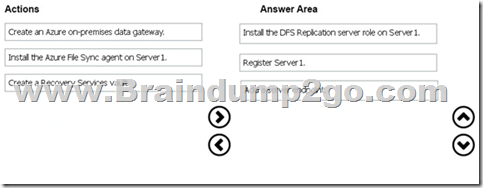
Explanation:
Step 1: Install the Azure File Sync agent on Server1
The Azure File Sync agent is a downloadable package that enables Windows Server to be synced with an Azure file share
Step 2: Register Server1.
Register Windows Server with Storage Sync Service
Registering your Windows Server with a Storage Sync Service establishes a trust relationship between your server (or cluster) and the Storage Sync Service.
Step 3: Add a server endpoint
Create a sync group and a cloud endpoint.
A sync group defines the sync topology for a set of files. Endpoints within a sync group are kept in sync with each other. A sync group must contain one cloud endpoint, which represents an Azure file share and one or more server endpoints. A server endpoint represents a path on registered server.
References: https://docs.microsoft.com/en-us/azure/storage/files/storage-sync-files-deployment-guide
QUESTION 46
Hotspot Question
You plan to create an Azure Storage account in the Azure region of East US 2.
You need to create a storage account that meets the following requirements:
– Replicates synchronously
– Remains available if a single data center in the region fails.
How should you configure the storage account? To answer, select the appropriate options in the answer area.
NOTE: Each correct selection is worth one point.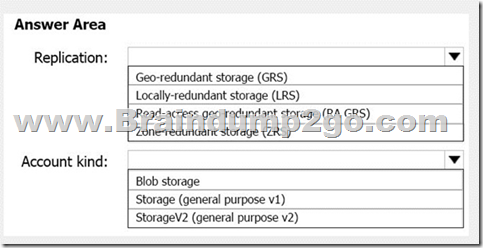
Answer: 
Explanation:
Box 1: Zone-redundant storage (ZRS)
Zone-redundant storage (ZRS) replicates your data synchronously across three storage clusters in a single region.
LRS would not remain available if a data center in the region fails GRS and RA GRS use asynchronous replication.
Box 2: StorageV2 (general purpose V2)
ZRS only support GPv2.
References:
https://docs.microsoft.com/en-us/azure/storage/common/storage-redundancy
https://docs.microsoft.com/en-us/azure/storage/common/storage-redundancy-zrs
QUESTION 47
Drag and Drop Question
You have an Azure subscription named Subscription1.
You create an Azure Storage account named contosostorage, and then you create a file share named data.
Which UNC path should you include in a script that references files from the data file share? To answer, drag the appropriate values to the correct targets. Each value may be used once, more than once, or not at all. You may need to drag the split bar between panes or scroll to view content.
NOTE: Each correct selection is worth one point.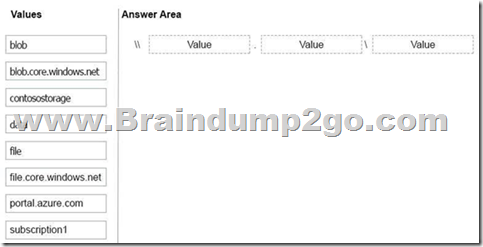
Answer: 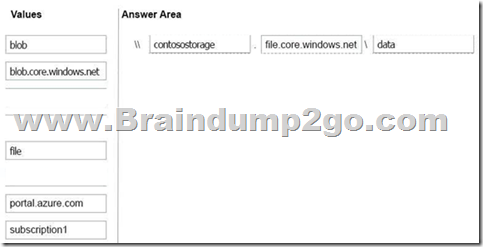
Explanation:
Box 1: contosostorage
The name of account
Box 2: file.core.windows.net
Box 3: data
The name of the file share is data.
Example:
References: https://docs.microsoft.com/en-us/azure/storage/files/storage-how-to-use-files-windows
QUESTION 48
Hotspot Question
You have an Azure Storage accounts as shown in the following exhibit.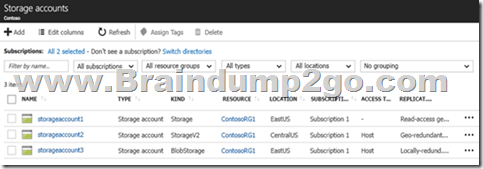
Use the drop-down menus to select the answer choice that completes each statement based on the information presented in the graphic.
NOTE: Each correct selection is worth one point.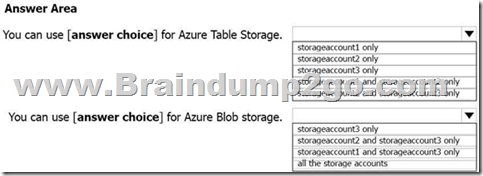
Answer: 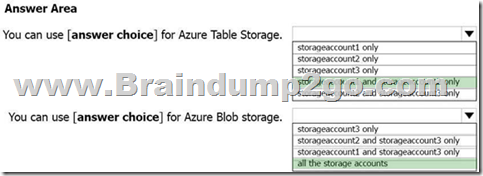
Explanation:
Box 1: storageaccount1 and storageaccount2 only
Box 2: All the storage accounts
Note: The three different storage account options are: General-purpose v2 (GPv2) accounts, General-purpose v1 (GPv1) accounts, and Blob storage accounts. General-purpose v2 (GPv2) accounts are storage accounts that support all of the latest features for blobs, files, queues, and tables.
Blob storage accounts support all the same block blob features as GPv2, but are limited to supporting only block blobs.
General-purpose v1 (GPv1) accounts provide access to all Azure Storage services, but may not have the latest features or the lowest per gigabyte pricing.
References: https://docs.microsoft.com/en-us/azure/storage/common/storage-account-options
QUESTION 49
Drag and Drop Question
You have an Azure subscription that contains an Azure virtual machine named VM1.
VM1 runs Windows Server 2016 and is part of an availability set.
VM1 has virtual machine-level backup enabled.
VM1 is deleted.
You need to restore VM1 from the backup. VM1 must be part of the availability set.
Which three actions should you perform in sequence? To answer, move the appropriate actions from the list of actions to the answer area and arrange them in the correct order.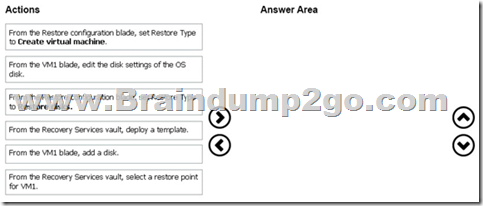
Answer: 
QUESTION 50
Hotspot Question
You have an Azure subscription named Subscription1.
You plan to deploy an Ubuntu Server virtual machine named VM1 to Subscription1.
You need to perform a custom deployment of the virtual machine.
A specific trusted root certification authority (CA) must be added during the deployment.
What should you do? To answer, select the appropriate options in the answer area.
NOTE: Each correct selection is worth one point.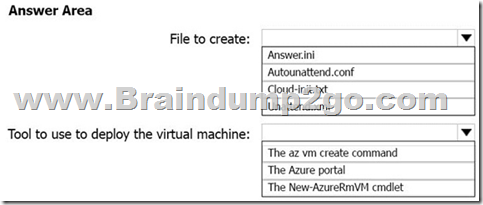
Answer: 
Explanation:
Box 1: Unattend.xml
In preparation to deploy shielded VMs, you may need to create an operating system specialization answer file. On Windows, this is commonly known as the “unattend.xml” file. The New-ShieldingDataAnswerFile Windows PowerShell function helps you do this. Starting with Windows Server version 1709, you can run certain Linux guest OSes in shielded VMs. If you are using the System Center Virtual Machine Manager Linux agent to specialize those VMs, the New-ShieldingDataAnswerFile cmdlet can create compatible answer files for it.
Box 2: The Azure Portal
You can use the Azure portal to deploy a Linux virtual machine (VM) in Azure that runs Ubuntu.
References: https://docs.microsoft.com/en-us/azure/virtual-machines/linux/quick-create-portal
QUESTION 51
Hotspot Question
You have an Azure subscription named Subscription1. Subscription1 contains two Azure virtual machines named VM1 and VM2.
VM1 and VM2 run Windows Server 2016. VM1 is backed up daily by Azure Backup without using the Azure Backup agent.
VM1 is affected by ransomware that encrypts data.
You need to restore the latest backup of VM1.
To which location can you restore the backup? To answer, select the appropriate options in the answer area.
NOTE: Each correct selection is worth one point.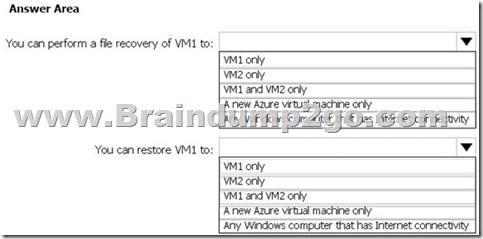
Answer: 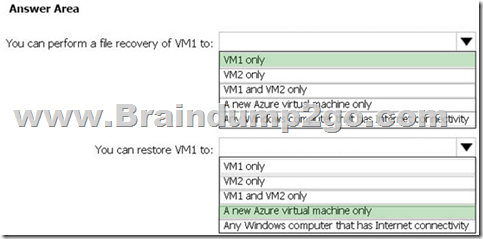
Explanation:
Box 1: VM1 only
To restore files or folders from the recovery point, go to the virtual machine and choose the desired recovery point.
Box 2: A new Azure virtual machine only
On the Restore configuration blade, you have two choices:
Create virtual machine
Restore disks
References:
https://docs.microsoft.com/en-us/azure/backup/backup-azure-restore-files-from-vm
https://docs.microsoft.com/en-us/azure/backup/backup-azure-arm-restore-vms
QUESTION 52
Hotspot Question
You purchase a new Azure subscription named Subscription1.
You create a virtual machine named VM1 in Subscription1.
VM1 is not protected by Azure Backup.
You need to protect VM1 by using Azure Backup. Backups must be created at 01:00 and stored for 30 days.
What should you do? To answer, select the appropriate options in the answer area.
NOTE: Each correct selection is worth one point.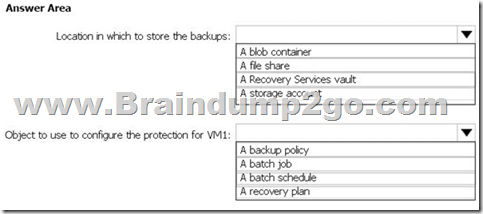
Answer: 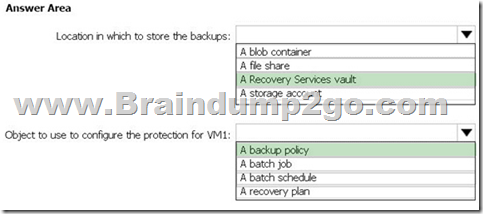
Explanation:
Box 1: A Recovery Services vault
A Recovery Services vault is an entity that stores all the backups and recovery points you create over time.
Box 2: A backup policy
What happens when I change my backup policy?
When a new policy is applied, schedule and retention of the new policy is followed.
References:
https://docs.microsoft.com/en-us/azure/backup/backup-configure-vault
https://docs.microsoft.com/en-us/azure/backup/backup-azure-backup-faq
QUESTION 53
Drag and Drop Question
You have an availability set named AS1 that contains three virtual machines named VM1, VM2, and VM3.
You attempt to reconfigure VM1 to use a larger size. The operation fails and you receive an allocation failure message.
You need to ensure that the resize operation succeeds.
Which three actions should you perform in sequence? To answer, move the appropriate actions from the list of actions to the answer area and arrange them in the correct order.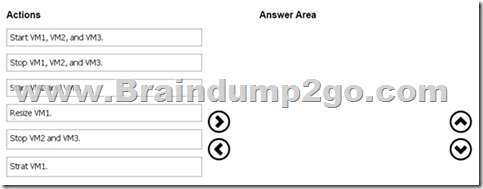
Answer: 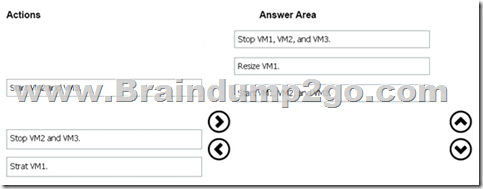
QUESTION 54
Drag and Drop Question
You have an Azure subscription. The subscription includes a virtual network named VNet1. Currently, VNet1 does not contain any subnets.
You plan to create subnets on VNet1 and to use application security groups to restrict the traffic between the subnets.
You need to create the application security groups and to assign them to the subnets.
Which four cmdlets should you run in sequence? To answer, move the appropriate cmdlets from the list of cmdlets to the answer area and arrange them in the correct order.
Answer: 
QUESTION 55
Hotspot Question
You have an Azure subscription named Subscription1.
Subscription1 contains the virtual machines in the following table.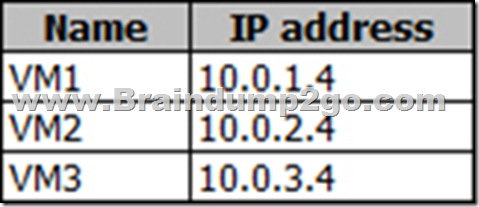
Subscription1 contains a virtual network named VNet1 that has the subnets in the following table.
VM3 has a network adapter named NIC3. IP forwarding is enabled on NIC3. Routing is enabled on VM3.
You create a route table named RT1. RT1 is associated to Subnet1 and Subnet2 and contains the routes in the following table.
You apply RT1 to Subnet1.
For each of the following statements, select Yes if the statement is true. Otherwise, select No.
NOTE: Each correct selection is worth one point.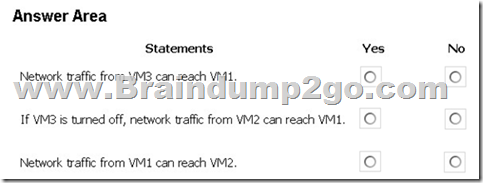
Answer: 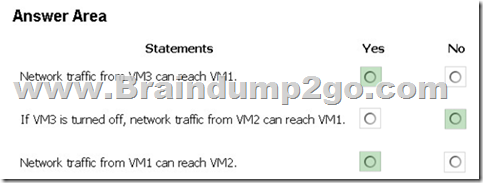
Explanation:
Box 1: Yes
Traffic from VM1 and VM2 can reach VM3 thanks to the routing table, and as IP forwarding is enabled on VM3, traffic from VM3 can reach VM1.
Box 2: No
VM3, which has IP forwarding, must be turned on, in order for traffic from VM2 to reach VM1.
Box 3: Yes
The traffic from VM1 will reach VM3, which thanks to IP forwarding, will send the traffic to VM2.
References: https://www.quor
a.com/What-is-IP-forwarding
!!!RECOMMEND!!!
1.|2019 Latest AZ-102 Exam Dumps (PDF & VCE) Instant Download:
https://www.braindump2go.com/az-102.html
2.|2019 Latest AZ-102 Study Guide Video Instant Download: